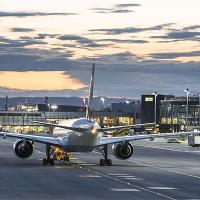[ad_1]
BRUSSELS – European airport trade body, ACI Europe, released its air traffic report for March and Q1. The report is the only air transport report which includes all types of civil aviation passenger flights: full service, low cost and charter. It reveals that during the first quarter of this year, passenger traffic at Europe’s airports grew by an average +4.4%.
Olivier Jankovec, Director General of ACI Europe commented: “While softening compared to the past 2 years, passenger traffic remains dynamic – especially in the EU. This reflects improved economic data in the Eurozone and a more benign global economic outlook for now. But, while prospects have somehow moved from a half-empty glass to a half-full one, black spots still abound. Volatile oil prices, continued airline consolidation, ATM disruptions and increasing airport capacity constraints will limit airline capacity growth in the coming months. On the demand side, sliding imports and a risk of trade escalations are ever-present. And over the medium-term, rising concerns about aviation’s environmental impact will likely add to the downward pressures.”
EU airports passenger traffic at +4.8%
The EU market kept reporting robust growth in Q1, despite March traffic (+4.1%) being affected by the Easter holidays slipping to April this year.
Airports in Austria (+21.6%) and Estonia (+13.3%) posted double-digit growth in Q1 while those in Poland, Slovakia, Romania, Greece, Ireland, Portugal, Spain and Luxembourg also grew well above the EU average. Conversely, Sweden was the only country reporting passenger traffic declining (-4.1%) mainly as a result of the country’s aviation tax and fast increasing environmental pressures limiting demand. Meanwhile, passenger traffic barely grew in Denmark (+0.9%) and significantly underperformed in Belgium (+1.9%) due to ATM strikes as well as in the Netherlands (+1.8%), due to severe airport capacity limitations.
Amongst larger/capital EU airports, the best results were achieved by Berlin-TXL (+32.4%), Vienna (+24.6%), Tallinn (+13.3%), Dusseldorf (+12.5%), Milan-Malpensa (+10.6%), Palma de Mallorca (+10.2%), Athens (+9.5%) and Luxembourg (+9.3%).
Non-EU airports passenger traffic at +2.9%
Airports in the non-EU market grew at a slower pace in Q1, mainly due to traffic losses in Turkey (-3.7% – as a result of the recession affecting the country), Iceland (-8.8% – following the bankruptcy of long/medium haul budget airline WOW in the final days of March). However, passenger traffic in Russia, Ukraine, Georgia and Belarus remained extremely dynamic, achieving double-digit growth.
The best performances amongst larger/capital non-EU airports came from Moscow-Sheremetevo (+17.6%), Moscow-Vnukovo (+13.2%), Saint Petersburg (+14.7%), Minsk (+15.7%), Tbilisi (+11.2%), Kiev (+15.2%) Antalya (+13.2%) and Sochi (+12.9%).
Weaker majors and smaller regionals
Passenger traffic at the Majors (top 5 European airports) grew by just +1.7% during Q1. Paris CDG (+5.7%), led the league, followed by Frankfurt (+2.5%), while gains were limited at capacity constrained Amsterdam-Schiphol (+1.6%) and London-Heathrow (+1.4%). Istanbul-Ataturk saw passenger traffic declining (-2.7%).
Regional airports, especially smaller ones, tended to underperform the European average in Q1. However, several achieved particularly impressive growth – boosting their off-season potential as leisure destinations and yielding the results of proactive route development & marketing. These included: Kharkiv (+28.8%), Dubrovnik (+25.4%), Paphos (+21.8%), Ostend (+21.2%), Toulon (+21%), Seville (+21.4%), Memmingerberg (+20.3%), Thessaloniki (+18.2%), Bari (+17.7%), Krakow (+16.1%), Wroclaw (+14.5%), Pau (+14.8%), Nantes (+14.2%), Faro (+12.3%) and Edinburgh (+12%).
Aircraft movements
Aircraft movements increased by +3.1% in Q1, with EU airports ahead (+3.3%) compared to non-EU ones (+2.1%) – on a slightly downward trend over the period.
During Q1, airports welcoming more than 25 million passengers per year (Group 1), airports welcoming between 10 and 25 million passengers (Group 2), airports welcoming between 5 and 10 million passengers (Group 3) and airports welcoming less than 5 million passengers per year (Group 4) reported an average adjustment +4.0%, +5.8%, +4.2% and +3.0%.
The airports that reported the highest increases in passenger traffic are as follows:
- Group 1: Vienna (+24.6%), Moscow SVO (+17.6%), Antalya (+13.2%), Palma de Mallorca (+10.2%) and Dublin (+7.6%)
- Group 2: Berlin TXL (+32.4%), Kiev (+15.2%), St Petersburg (+14.7%), Moscow VKO (+13.2%) and Dusseldorf (+12.5%)
- Group 3: Seville (+21.4%), Thessaloniki (+18.2%), Bari (+17.7%), Krakow (+16.1%) and Nantes (+14.2%)
- Group 4: Taranto (+152.2%), Kutaisi (+101.0%), Ohrid (+63.9%), Bucharest (+55.8%) and Caen (+46.5%)
March figures
During the month of March, average passenger growth was +3.8%, even though the Easter holiday break took place in April. EU airports grew by +4.1% and non-EU ones by +2.7%.
Airports welcoming more than 25 million passengers per year (Group 1), airports welcoming between 10 and 25 million passengers (Group 2), airports welcoming between 5 and 10 million passengers (Group 3) and airports welcoming less than 5 million passengers per year (Group 4) reported an average adjustment +3.5%, +5.0%, +3.8% and +2.1%.
For March, the airports which reported the highest increases in passenger traffic are as follows:
- Group 1: Vienna (+23.9%), Moscow SVO (+17%), Antalya AYT (+11%), Dublin (+8.8%) and Paris CDG (+7.2%)
- Group 2: Berlin TXL (+25.1%), Moscow VKO (+16.9%), St Petersburg (+16.3%), Kiev (+15.6%) and Edinburgh (+14.8%)
- Group 3: Bari (+40.5%), Seville (+21%), Sochi (+18.9%), Krakow (+17.5%) and Valencia (+11.9%)
- Group 4: Taranto (+150%), Kos (+140.8%), Ohrid (+96.9%), Kutaisi (+82.8%) and Foggia (+77.8%)
The ‘ACI Europe Airport Traffic Report – March & Q1 2019’ includes 238 airports in total representing more than 88% of European air passenger traffic.
[ad_2]You can read more of the news on source
 Travelsmart
Travelsmart



